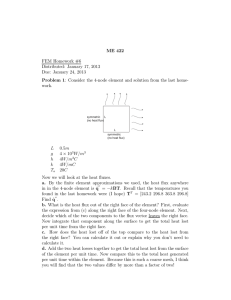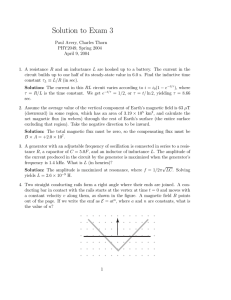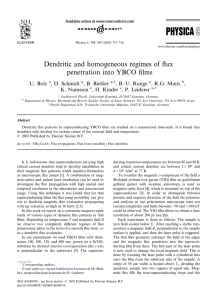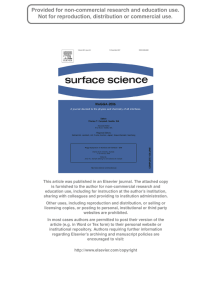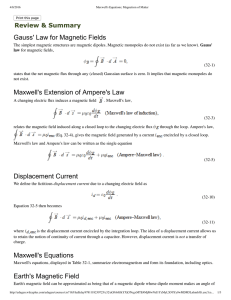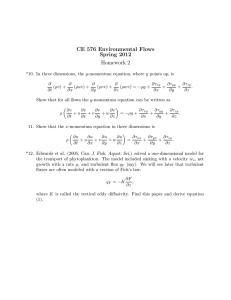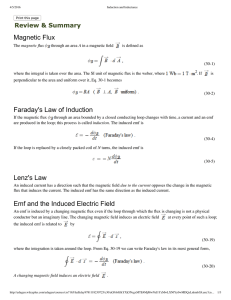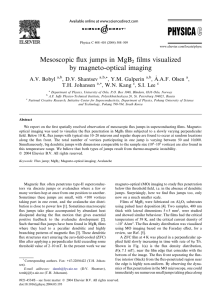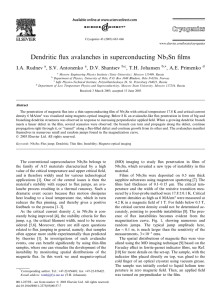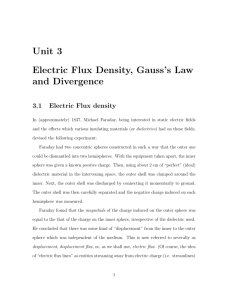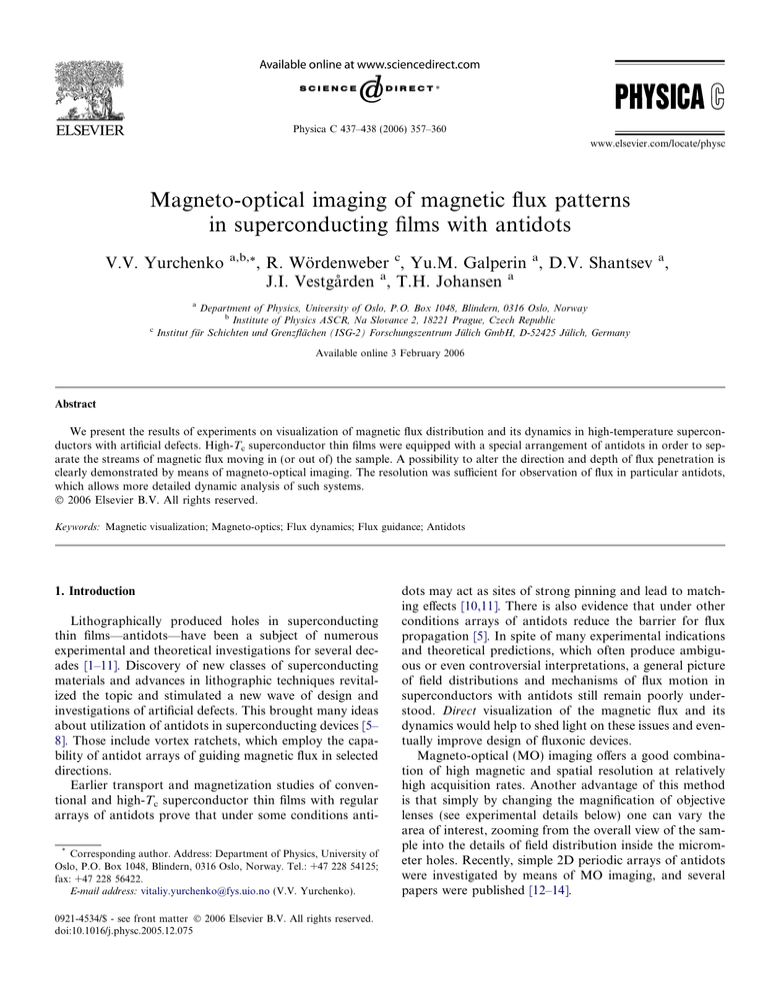
Physica C 437–438 (2006) 357–360
www.elsevier.com/locate/physc
Magneto-optical imaging of magnetic flux patterns
in superconducting films with antidots
V.V. Yurchenko
a,b,*
, R. Wördenweber c, Yu.M. Galperin a, D.V. Shantsev a,
J.I. Vestgården a, T.H. Johansen a
a
c
Department of Physics, University of Oslo, P.O. Box 1048, Blindern, 0316 Oslo, Norway
b
Institute of Physics ASCR, Na Slovance 2, 18221 Prague, Czech Republic
Institut für Schichten und Grenzflächen (ISG-2) Forschungszentrum Jülich GmbH, D-52425 Jülich, Germany
Available online 3 February 2006
Abstract
We present the results of experiments on visualization of magnetic flux distribution and its dynamics in high-temperature superconductors with artificial defects. High-Tc superconductor thin films were equipped with a special arrangement of antidots in order to separate the streams of magnetic flux moving in (or out of) the sample. A possibility to alter the direction and depth of flux penetration is
clearly demonstrated by means of magneto-optical imaging. The resolution was sufficient for observation of flux in particular antidots,
which allows more detailed dynamic analysis of such systems.
Ó 2006 Elsevier B.V. All rights reserved.
Keywords: Magnetic visualization; Magneto-optics; Flux dynamics; Flux guidance; Antidots
1. Introduction
Lithographically produced holes in superconducting
thin films—antidots—have been a subject of numerous
experimental and theoretical investigations for several decades [1–11]. Discovery of new classes of superconducting
materials and advances in lithographic techniques revitalized the topic and stimulated a new wave of design and
investigations of artificial defects. This brought many ideas
about utilization of antidots in superconducting devices [5–
8]. Those include vortex ratchets, which employ the capability of antidot arrays of guiding magnetic flux in selected
directions.
Earlier transport and magnetization studies of conventional and high-Tc superconductor thin films with regular
arrays of antidots prove that under some conditions anti*
Corresponding author. Address: Department of Physics, University of
Oslo, P.O. Box 1048, Blindern, 0316 Oslo, Norway. Tel.: +47 228 54125;
fax: +47 228 56422.
E-mail address: vitaliy.yurchenko@fys.uio.no (V.V. Yurchenko).
0921-4534/$ - see front matter Ó 2006 Elsevier B.V. All rights reserved.
doi:10.1016/j.physc.2005.12.075
dots may act as sites of strong pinning and lead to matching effects [10,11]. There is also evidence that under other
conditions arrays of antidots reduce the barrier for flux
propagation [5]. In spite of many experimental indications
and theoretical predictions, which often produce ambiguous or even controversial interpretations, a general picture
of field distributions and mechanisms of flux motion in
superconductors with antidots still remain poorly understood. Direct visualization of the magnetic flux and its
dynamics would help to shed light on these issues and eventually improve design of fluxonic devices.
Magneto-optical (MO) imaging offers a good combination of high magnetic and spatial resolution at relatively
high acquisition rates. Another advantage of this method
is that simply by changing the magnification of objective
lenses (see experimental details below) one can vary the
area of interest, zooming from the overall view of the sample into the details of field distribution inside the micrometer holes. Recently, simple 2D periodic arrays of antidots
were investigated by means of MO imaging, and several
papers were published [12–14].
358
V.V. Yurchenko et al. / Physica C 437–438 (2006) 357–360
In this article, we present MO images of a high-Tc superconducting film equipped with line segments of antidots of
different alignment with respect to the film edge. In particular, we investigate a ratchet configuration suggested in [5],
where the idea is to let the Lorentz force guide part of the
flux into dead ends. We analyze the observed field distributions and supplement the analysis with results of computer
simulations.
2. Experimental
2.1. Experimental technique
MO imaging is based on the Faraday effect, i.e. rotation
of the polarization plane of incident linearly polarized light
in materials with longitudinal optical birefringence in magnetic field. As Faraday active sensor we use a bismuthdoped ferrite garnet film with in-plane magnetization.
The garnet film was grown by liquid phase epitaxy on gadolinium gallium garnet substrate. The Faraday rotation
depends on the film thickness l, the magnetic field component H parallel to the incident light and a material parameter V, the so-called Verdet constant. At small field
values the Faraday rotation angle is given by:
h ¼ VlH
ð1Þ
Our MO imaging setup (see Fig. 1) consists of a mercury
lamp light source, a Leica polarizing microscope, an
Oxford optical cryostat, a pair of coils and a 12-bit CCD
(charge-coupled device) camera.
For mapping the field over the surface of a superconductor the MO layer is brought into close contact with the
sample. To double the Faraday effect and achieve better
reflectivity a thin aluminum mirror layer is sputtered on
CCD camera
analyzer
polarizer
MO film
beam
splitter
light source
mirror
Fig. 2. Optical image of the ratchet sample. The inset shows an enlarged
image. The distance between antidots is 8 lm.
the MO film. With our setup the spatial resolution goes
down to approximately 0.8 lm, which makes it possible
to visualize a few flux quanta localized at an antidot.
Due to a high dynamic response of the MO film
(<109 s) this method can be used for real time magnetic
visualization.
2.2. Samples
One of the key properties of superconducting thin film
devices like ratchets, is their capability of guiding magnetic
flux in selected directions. Changing the direction of vortex
motion can be realized by creating spatially inhomogeneous pinning potential or by introducing extended defects,
such as slits or large holes, which would locally modify
the current flow and, consequently, the direction of the
Lorentz force. For the present work a 150 nm thick
YBa2Cu3O7d thin film sample was produced by magnetron sputtering. The sample has the shape of a long strip
with a width of 500 lm. Holes with radii of 1 lm were produced by optical lithography and ion beam etching. The
antidots, separated by 8 lm, were arranged in the ratchet
configuration suggested by Wördenweber et al. [5]. This
consists of lines of equidistant antidots forming a 45° angle
with the edge of the superconducting strip, see Fig. 2. In
addition, short perpendicular segments of antidots were
introduced in order to separate the flux flow and guide
some flux into the dead-ends.
sample
3. Results and discussion
cold finger
coil
Fig. 1. Schematic drawing of the MO imaging setup.
Shown in Fig. 3 are MO images of the magnetic flux distribution in the sample at three consecutive values of external magnetic field. The field was slowly ramped up after
cooling the sample to 4 K in zero field. In our experiments
we used crossed polarizers, hence, the image brightness represents the magnitude of the local magnetic induction.
It is clearly seen in Fig. 3 that the flux density in the
antidots is significantly higher than in the surrounding
V.V. Yurchenko et al. / Physica C 437–438 (2006) 357–360
359
tion of magnetic flux rather than acting as additional pinning sites.
The resolution achieved in our experiments allows a
detailed analysis of the flux distribution and dynamics in
and around the antidots. At low applied fields, see
Fig. 3(a), only the holes next to the edge are populated with
flux. At elevated fields, (b) and (c), the flux is transferred
also to more distant holes while the occupation number
of the already populated holes increases. It seems that
every populated hole becomes a link in the chain transferring the flux: it receives flux from its neighbour and passes
it on to the next hole deeper into the sample.
Meanwhile, some flux leaving antidots penetrates into
the superconducting area ahead of it forming parabolic features seen in Fig. 3, and more clearly in Fig. 5. These
parabolas are especially pronounced at the ends of vertical
lines—the ‘‘dead-ends’’ (Fig. 5, right). They originate from
the last antidot in a row which does not have a possibility
to pass the flux on to the next hole. Hence all the flux
Fig. 4. Distribution of magnetic field in a strip with two holes obtained
from computer simulations (arbitrary units). Bends in current flow profile
cause parabolic distribution of magnetic field.
Fig. 3. MO images of flux distributions in the superconducting strip in an
increasing magnetic field after zero-field-cooling to T = 4 K. The images
(a)–(c) were taken at applied fields of Ba = 1 mT, 4 mT and 6 mT
respectively. The zigzag lines are domain walls in MO garnet film and
should be disregarded.
superconductor. The effective depth of flux penetration
along the lines of holes is also much greater than that
between them (or in intact films). Hence, we conclude that
the lines of antidots of radius R 1 lm facilitate propaga-
Fig. 5. Enlarged MO image of superconductor strip with antidot ratchet.
p = 8 lm, T = 4 k, B = 4 mT. Top (left) and bottom (right) edges of the
strip.
360
V.V. Yurchenko et al. / Physica C 437–438 (2006) 357–360
guided to the dead-end has to accumulate there or enters
the superconductor.
Fig. 5 (left) shows another specific type of antidots
where the two lines—diagonal and vertical—merge
together. Hence, the flux is guided to them via two channels, but can move on only via one diagonal channel. As
a result, these holes become overpopulated and some extra
flux has to penetrate the superconductor. Indeed, we can
see that these antidotes serve as the nucleation sites for relatively large parabolic features on the images. At high
fields a whole line of antidots represents a cascade of
parabolas with the centres in the holes.
The origin of parabolic flux distribution is the meandering of the current around the holes. The parabolas seen in
the MO images separate domains of different current orientations (they are often called d-lines) [15,16]. This is illustrated by Fig. 4, which shows the result of computer
simulations of flux penetration in a thin superconducting
strip with current–voltage curve E j n, n = 15 based on
the formalism developed by Brandt [17,18]. The strip contains two holes which give rise to parabolic features in the
flux pattern (the flux density is constant along the lines).
Finally, it is known that an antidote cannot carry more
flux quanta than a certain saturation number [1]. In the
present experiment we never reach this number since the
flux density in the holes keep increasing while we ramp
the applied field up to the maximal value of 10 mT.
4. Conclusions
We demonstrated by means of magneto-optics that in
YBCO thin films with 1D arrays of artificially patterned
holes the propagation of magnetic flux is significantly facilitated along the lines of artificial defects.
Every hole transfers some flux to the next hole and
some—to the superconductor ahead of it. The flux in the
superconductor acquires a parabolic pattern with centers
of parabolas sitting in the antidots. An additional evidence
of flux guidance by the hole arrays comes from the observation of most pronounced parabolas at the antidots fed by
two flux channels or situated at the dead-ends, where the
further flux transfer is impossible.
Acknowledgements
The work was supported by the Research Council of
Norway, Grant. No. 158518/431 (NANOMAT). Help
and valuable remarks of R. Kutzner, Dr. E.K. Hollmann,
Prof. A.V. Bobyl, B. Rosewig and Å.A.F. Olsen are
acknowledged.
References
[1] G.S. Mkrtchyan, V.V. Shmidt, Sov. Phys. JETP 34 (1972) 195.
[2] A.T. Fiory, A.F. Hebard, S. Somekh, Appl. Phys. Lett. 32 (1) (1978)
73.
[3] H. Nordborg, V.M. Vinokur, Phys. Rev. B 62 (2000) 12409.
[4] A. Buzdin, D. Feinberg, Physica C 256 (1996) 303.
[5] R. Wördenweber et al., Phys. Rev. B 69 (2004) 184504.
[6] C. Reichhardt et al., Phys. Rev. B 57 (1998) 7937.
[7] C. Reichhardt, C.J. Olson Reichhardt, Physica C 404 (2004) 302.
[8] B.Y. Zhu et al., Phys. Rev. B 68 (2003) 014514.
[9] J. Van de Vondel et al., Phys. Rev. Lett. 94 (2005) 057003.
[10] V.V. Moshchalkov et al., Phys. Rev. B 54 (1996) 7385.
[11] R. Wordenweber et al., Physica C 332 (2000) 27.
[12] R. Surdeanu et al., Europhys. Lett. 54 (5) (2001) 682.
[13] M. Pannetier, Phys. Rev. B 67 (2003) 212501.
[14] M.S. Welling, Physica C 404 (2004) 410.
[15] Ch. Jooss, J. Albrecht, H. Kuhn, S. Leonhardt, H. Kronmuller, Rep.
Prog. Phys. 65 (2002) 651.
[16] A.M. Campbell, J.E. Evetts, Critical Currents in Superconductors,
Taylor & Francis, London, 1972;
A.M. Campbell, J.E. Evetts, Adv. Phys. 21 (1972) 199.
[17] E.H. Brandt, Phys. Rev. B 46 (1992) 8628.
[18] E.H. Brandt, Phys. Rev. B 52 (1995) 15442.

